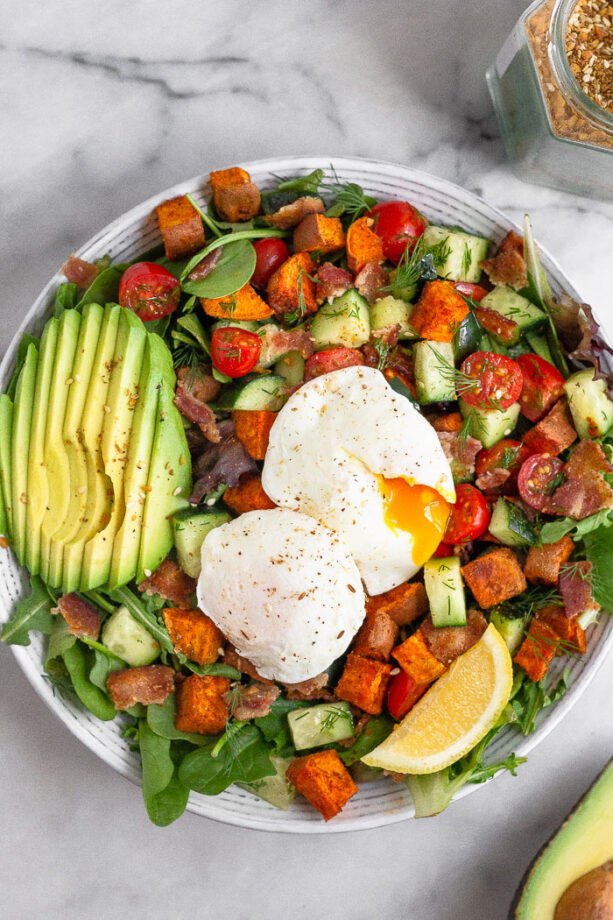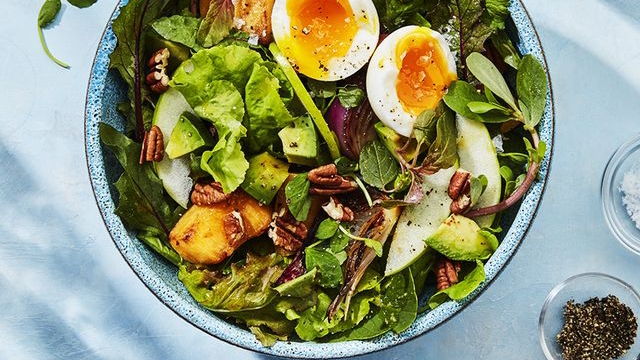Salads for breakfast are the recent nutritional obsession.
Whilst eating veggies for breakfast is not prevalent in the Western diet, it is quite common in other cultures’ diets.
Salads for breakfast are an excellent way to start the day with nutrient-dense foods. They may also improve your mood and productivity, as well as your digestion and weight loss.
Breakfast salads are discussed in this article, along with their health benefits and how to make your own. According to Healthline.
Leafy greens and cruciferous vegetables are among the highest nutritious vegetables available, making them an excellent salad base.
Kale, collard greens, spinach, cabbage, beet greens, watercress, romaine lettuce, Swiss chard, arugula, bok choy, and turnip greens are examples of leafy greens.
Cauliflower, broccoli, Brussel sprouts, bok choy, and cabbage are all cruciferous vegetables.
You can add better vegetables of your selection to these greens and cruciferous vegetables. Choose a range of hues to maximize your vitamin and mineral consumption. Carrots, bell peppers, and tomatoes are all good examples.
Including a dose of protein in your morning salad helps to curb appetite and sustain fullness while also supporting strong bones and maintaining muscle mass.
Seafood, eggs, meat, and dairy products like cheese are all animal-based sources of protein.
Tofu, tempeh, beans, peas, nuts, seeds, and specific whole grains, such as quinoa, are all plant sources.
Carbohydrates are your body’s default fuel source. It’s a good idea to add some to your breakfast salad to help you stay energized until your next meal.
Sugars, starches, and fibre are the three types of carbohydrates. Sugars, which are classified as simple carbohydrates, are frequently connected to obesity, heart disease, and type 2 diabetes, especially when processed.
Starches and fibres, on the other hand, are more complicated. They digest more slowly, which can help you maintain a balanced blood sugar level.
Simple carbs like processed grains, crackers, and croutons should be avoided in favor of complex carbs like whole grains, fruits, legumes, or starchy vegetables.
Sweet potatoes, apples, black beans, and butternut squash are all good sources of healthful carbohydrates.
Including lipids in your breakfast salad can aid in the absorption of fat-soluble.
Whole plant foods like avocados, olives, nuts, and seeds are the finest sources of fat. Vitamins, minerals, and beneficial plant components are more abundant in them than in processed fats like vegetable oils.
As a result, homemade dressings made with plant oils like olive, avocado, or flaxseed oil are a healthier alternative to store-bought dressings, which often contain added salt or sugar.
Ingredients to avoid
To make the healthiest breakfast salad possible, use as many whole, minimally processed foods as possible while avoiding too processed meals.
The following substances should be avoided or kept to a minimum.
Fried foods, fatty meats, and sodium-rich meat substitutes are all high in sodium.
These will add a lot of fat and salt to your meal that you don’t need.
Salad dressings from the store.
These are typically high in sugar and salt, but poor in vitamins and minerals.
Nuts that have been candied or roasted in oil.
Instead, choose raw or dry-roasted nuts, which are often covered in sugar or contain extra fat.
Grain that has been refined. White spaghetti, croutons, and crackers are examples of foods that are low in fibre, vitamins, and minerals. Dried fruit that has been sweetened. Dried fruit is a healthful substitute for fresh fruit. Sweetened kinds, on the other hand, should be avoided because they contain excessive levels of added sugar.



